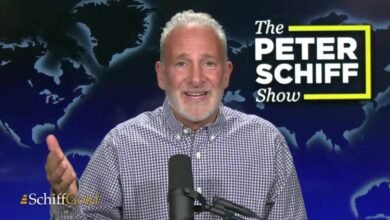‘SELL AMERICA’ PANIC: World is Quickly Ditching US Assets (Uncut) 04-15-2025
‘SELL AMERICA’ PANIC: World is Quickly Ditching US Assets as De-dollarization Is Accelerating
Hello everyone, welcome back. Thank you so much for being here today. If you’re new here, make sure that you are subscribed to worldaffairsandcontext.com for more content.
You’ll find interviews there and so much more. And do consider supporting my work. It is very much appreciated.
Today we’re diving into a surprising twist in global economics, how President Trump’s tariffs originally meant to protect the US economy and to protect US manufacturing may have actually pushed investors away from American markets and triggered a shift in global capital. So let’s break that down. For decades, the world saw the United States as the safest place to invest.
Every year, nearly $2 trillion flow into the country, buying stocks, buying bonds, funding businesses, and so much more. In fact, America’s share of global capital flows jumped to 41% after the pandemic. But you know what? That has already changed.
The loss of confidence in the United States dollar as a global reserve currency has accelerated since the introduction of new tariffs and it increased economic instability globally. As you can see here, the share of the US dollar as a global reserve currency has been on a downward spiral. Right now, its share stands at roughly 57% and it continues to decline.
Trump’s whiplash tariffs allegedly aimed at boosting American industries had an unintended consequence. And I should add here, unintended but quite predictable consequence. When you prioritize political agenda over economic reasons, when you implement your trade policies, this is what you get.
Instead of strengthening the US dollar, tariffs weakened the global reserve currency. Tariffs coupled with using economic sanctions as a weapon against your non-aligned states and, of course, the elephant in the room, the US debt crisis. We’re now looking at $37 trillion in national debt.
Interest costs to service that debt have already surpassed defense spending and Medicare spending. It is now second to social security costs. As you can see here, the interest on national debt is expected to rise sharply as the federal government’s ability to cover other important programs such as defense and social entitlements will continue to weaken.
That is a signal investors are selling US assets and moving their money elsewhere right now. Traditionally, a strong US dollar was a given. It’s been the world’s reserve currency for decades and investors trusted the government to protect its value.
Well, that has already changed. But now, even Trump’s former economic advisor, Stephen Myron, is questioning that old approach and how safe the US dollar actually is in this unpredictable global environment. He argues that the strong dollar hurts US workers and global competitiveness.
The instability in US economic and, more specifically, trade policy makes global investors really nervous. If Washington isn’t standing by the dollar like it used to, they might actually start looking elsewhere for returns. And this is precisely what they’re doing.
US markets are underperforming. The S&P 500 is among the worst global indices this year. Meanwhile, Asian and European stocks are rising.
Even the bond market is feeling the pressure now. As treasury yields increased while the value of the US dollar declined, which is a very alarming trend that supports the argument of the loss of confidence in the US dollar, investors continue to sell US equities. The White House seems to recognize this, hinting at tariff rollbacks to calm things down, but it might be too late.
US Commerce Secretary Howard Lutnick has warned that smartphones and other consumer electronics imported to America from China will still face tariffs. What he, referring to President Trump, doing is he’s saying they’re exempt from reciprocal tariffs, but they are included in the semiconductor tariffs, which are coming in probably a month or two. Needless to say, Lutnick’s comments, coupled with President Trump’s latest commentary, sparked yet another wave of concerns over the weekend and on Monday.
On top of that, nearly 30% of US public debt is held by foreign investors. If they start losing confidence, which they have already started to lose confidence, we’re talking about serious long-term effects on America’s financial stability. Once the trust in the US dollar declines even more as a result of Washington’s failed policies, it will be a challenge to build it back without foundational shifts in US foreign policy and how it positions itself globally.
You can’t simply undo decades of bullying other countries, sanctioning them into oblivion and flip-flopping on tariffs on a daily basis. US treasuries are traditionally regarded as the safest form of investment because they are backed by the full faith of the US government. The recent sell-off is a major red flag.
Investors typically sell stocks when the economy is slowing, and they turn to bonds. The problem is US bonds are no longer viewed as a desirable investment, and to make them more attractive, yields would have to increase. So, the recent market activity shows that neither US equities nor bonds are viewed as highly desirable assets in this unstable and quite unpredictable geopolitical environment.
The bond sell-off may be about the growing possibility of a default risk, and investors recognize this. Some analysts are now warning about a Sell America Inc. trend, the idea that foreign investors no longer see US assets as the safe and dependable bet that they once were.
But it’s not all doom and gloom, of course, and if these risks are recognized now, and if policies are adjusted swiftly, there is still hope for a more positive outcome for the global economy, including the US economy. The US economy is still the largest in the world, and it does remain a powerful magnet for investment. Billions are still flowing into auto plants, tech, and data centers across the country.
Even this week, a 10-year treasury bond auction got substantial interest from buyers, which is a small but very important sign that confidence hasn’t disappeared entirely. There is still some of it left. The big question is whether this is just a temporary reaction or the beginning of a fundamental reordering of global investment patterns and monetary system.
If the world truly starts turning away from the US markets, it could reshape how money moves, how the dollar is valued, and even how America funds its growth. Trump’s tariffs may have unintentionally sparked something much bigger than a trade war, a new era in the global economy. As the trust in the United States declines, the emergence of a multi-polar world and the need to create reliable financial architecture for the global majority is that much more important.
Let me know what you think about the latest events and the news. I would love to hear from you as always. Thank you for watching.
If you found this interesting, make sure that you are subscribed to WorldAffairsAndContext.com. I would love to see you there and enjoy the rest of your day. I will see you back here tomorrow. Bye for now.




